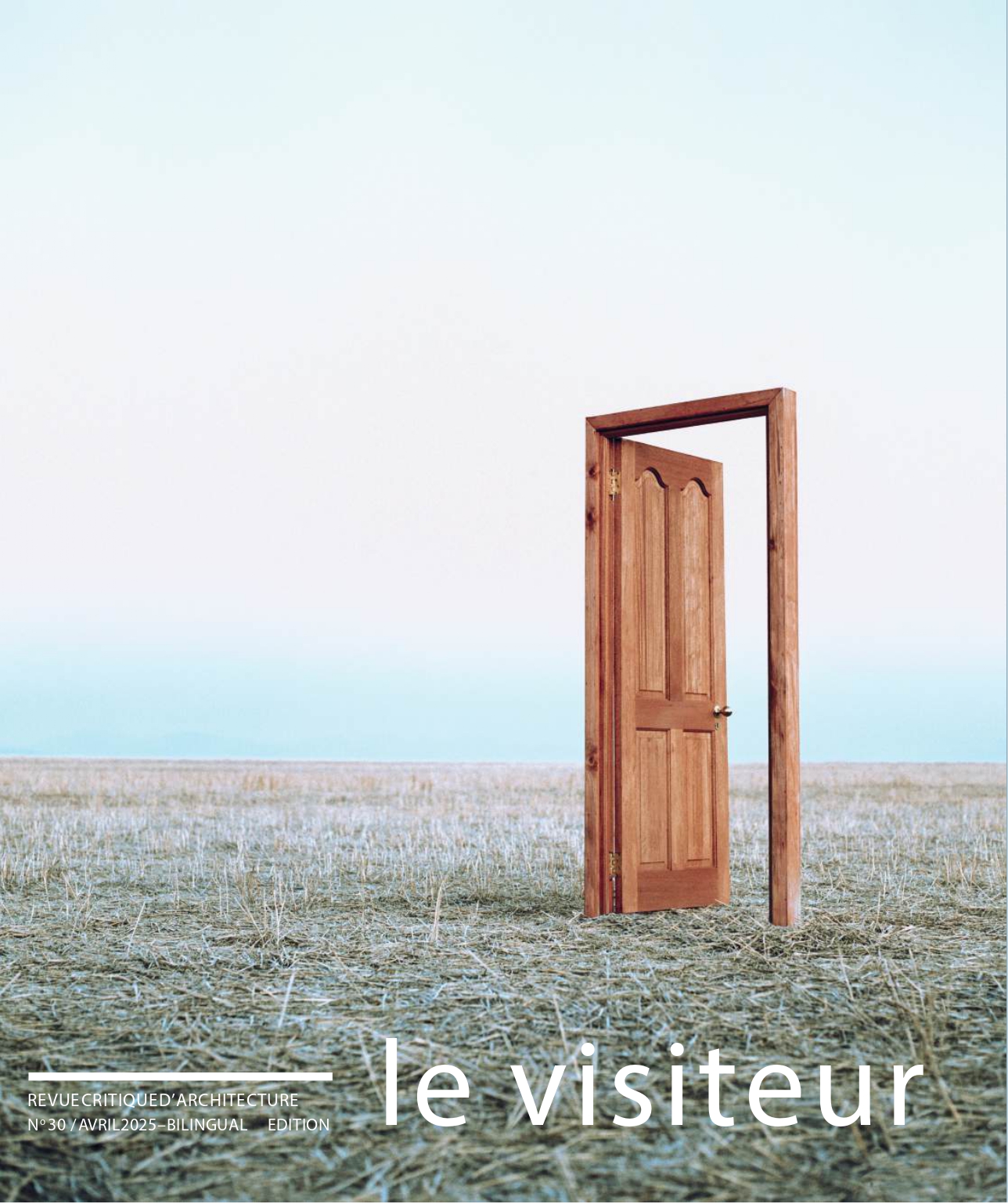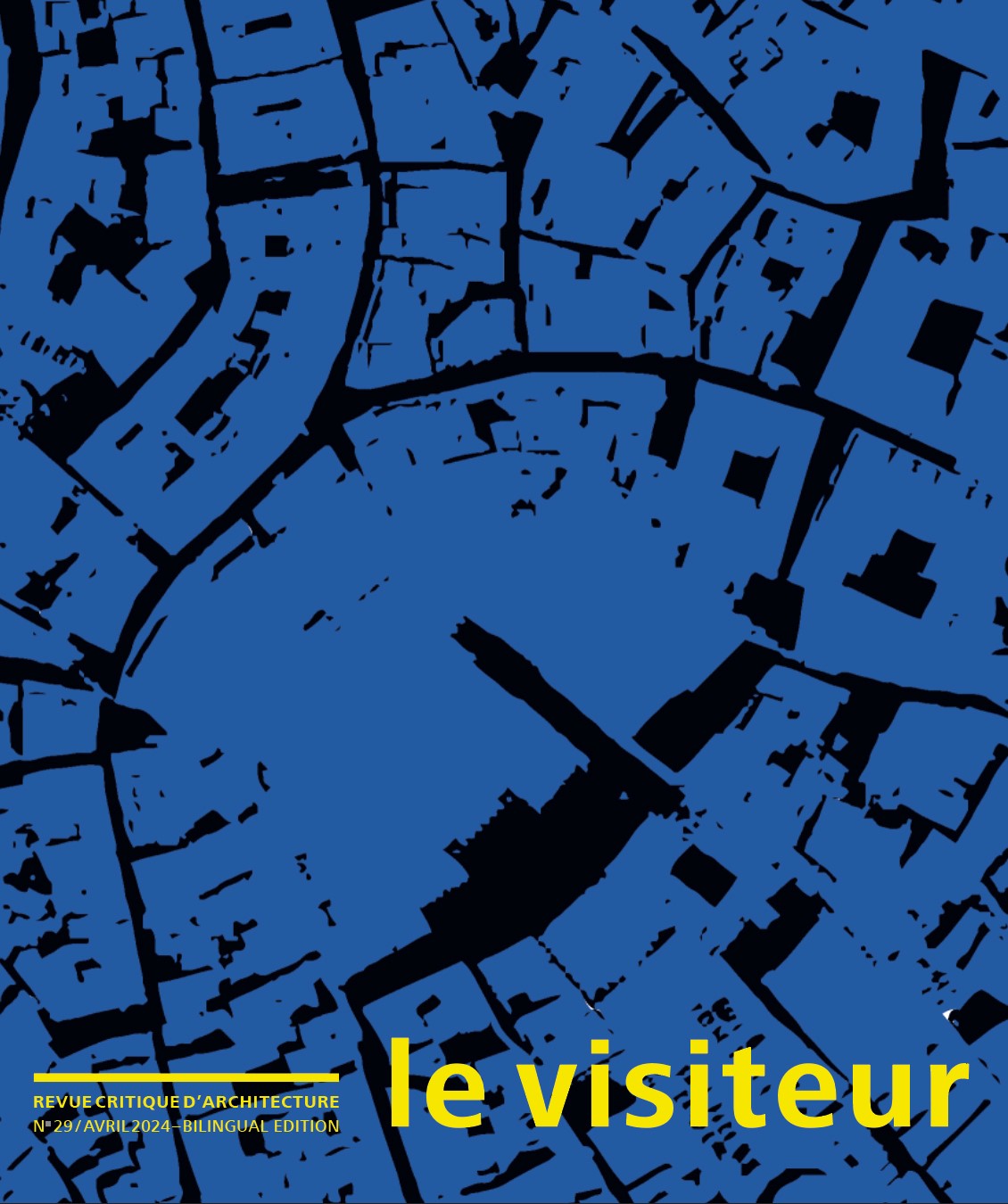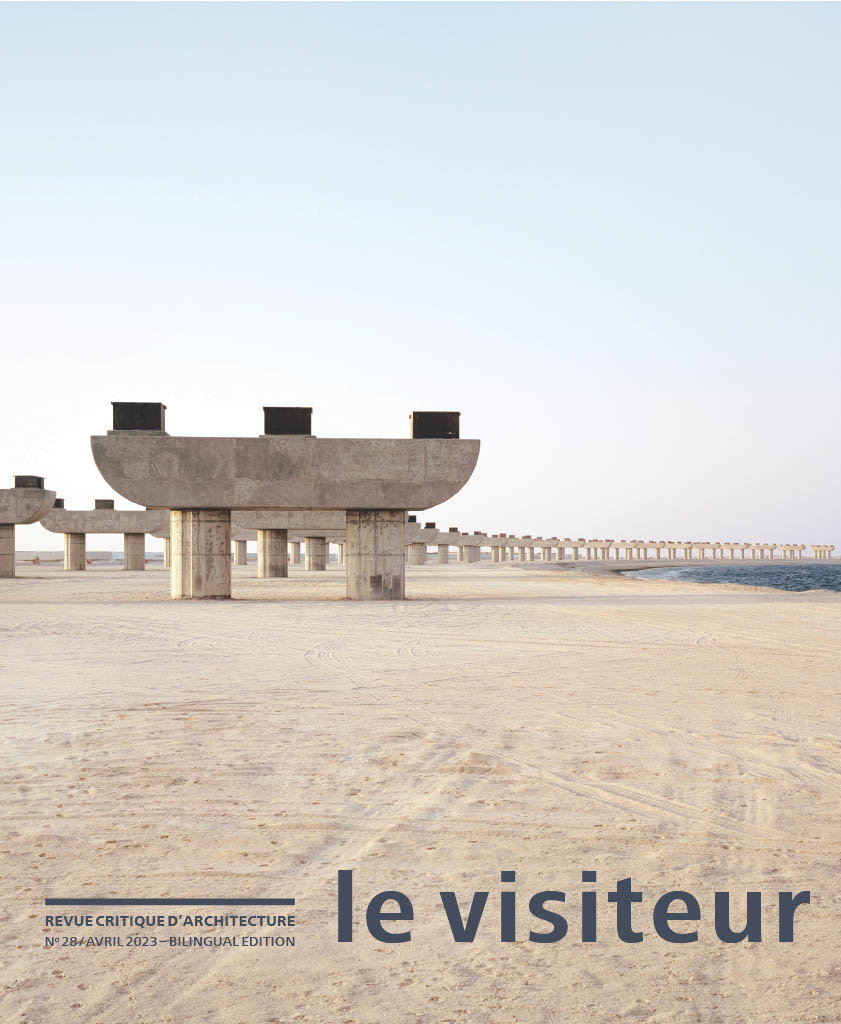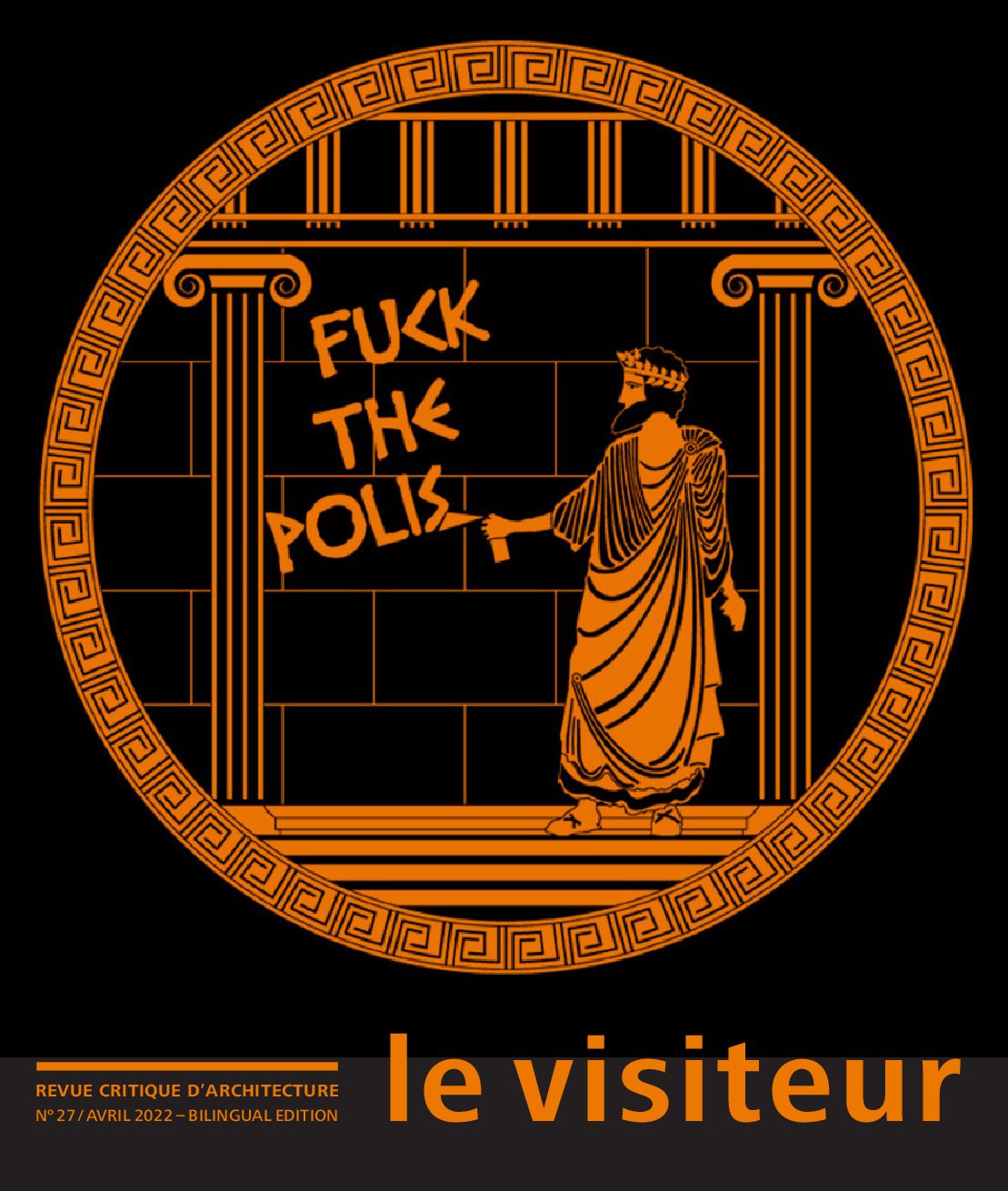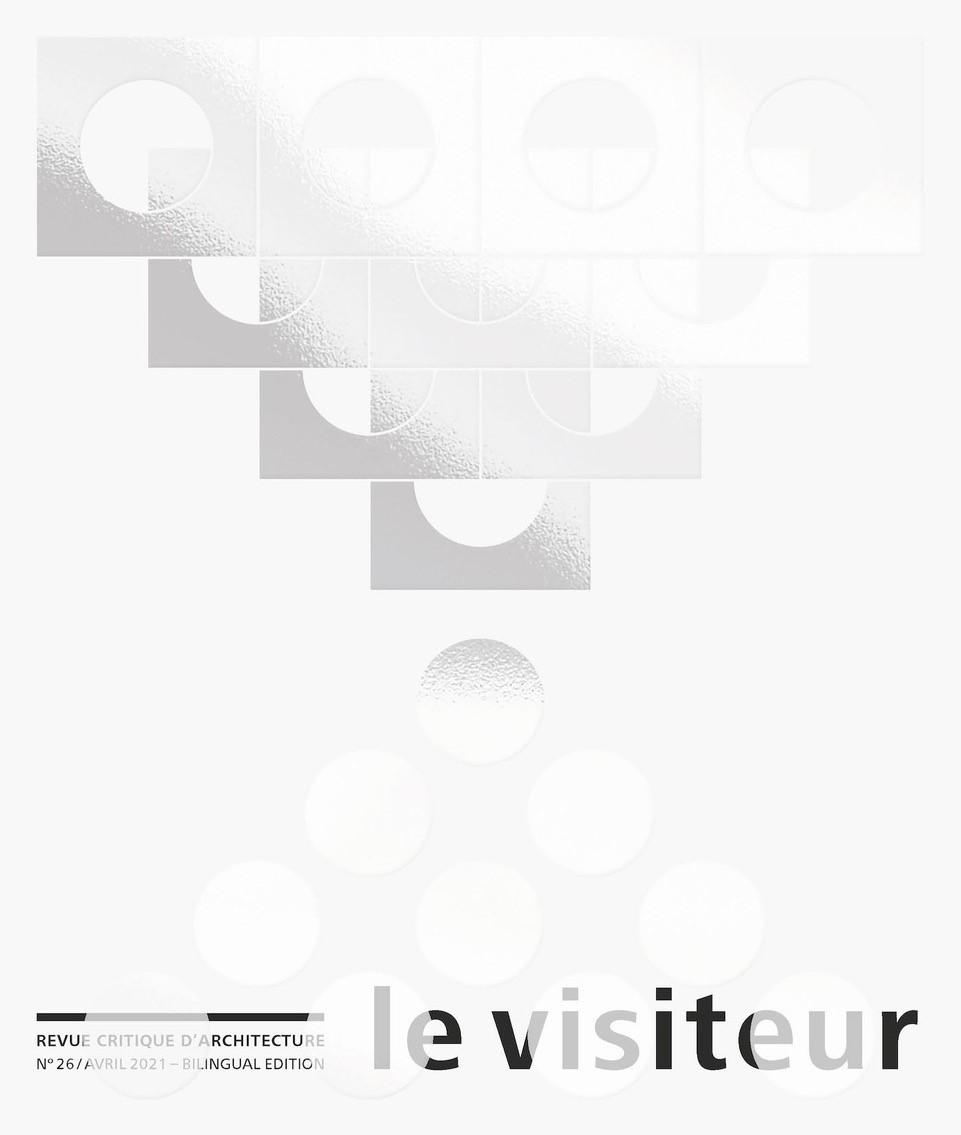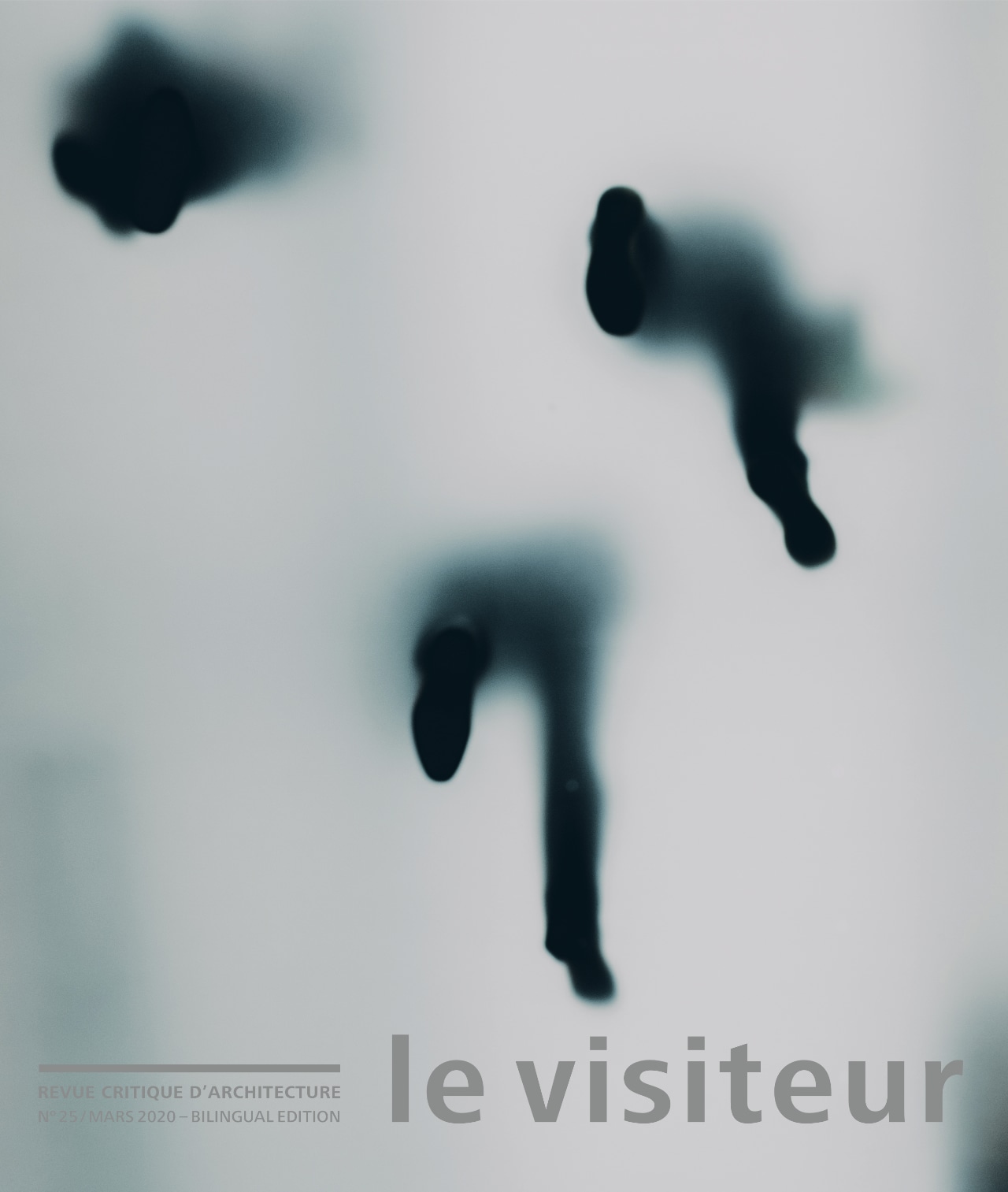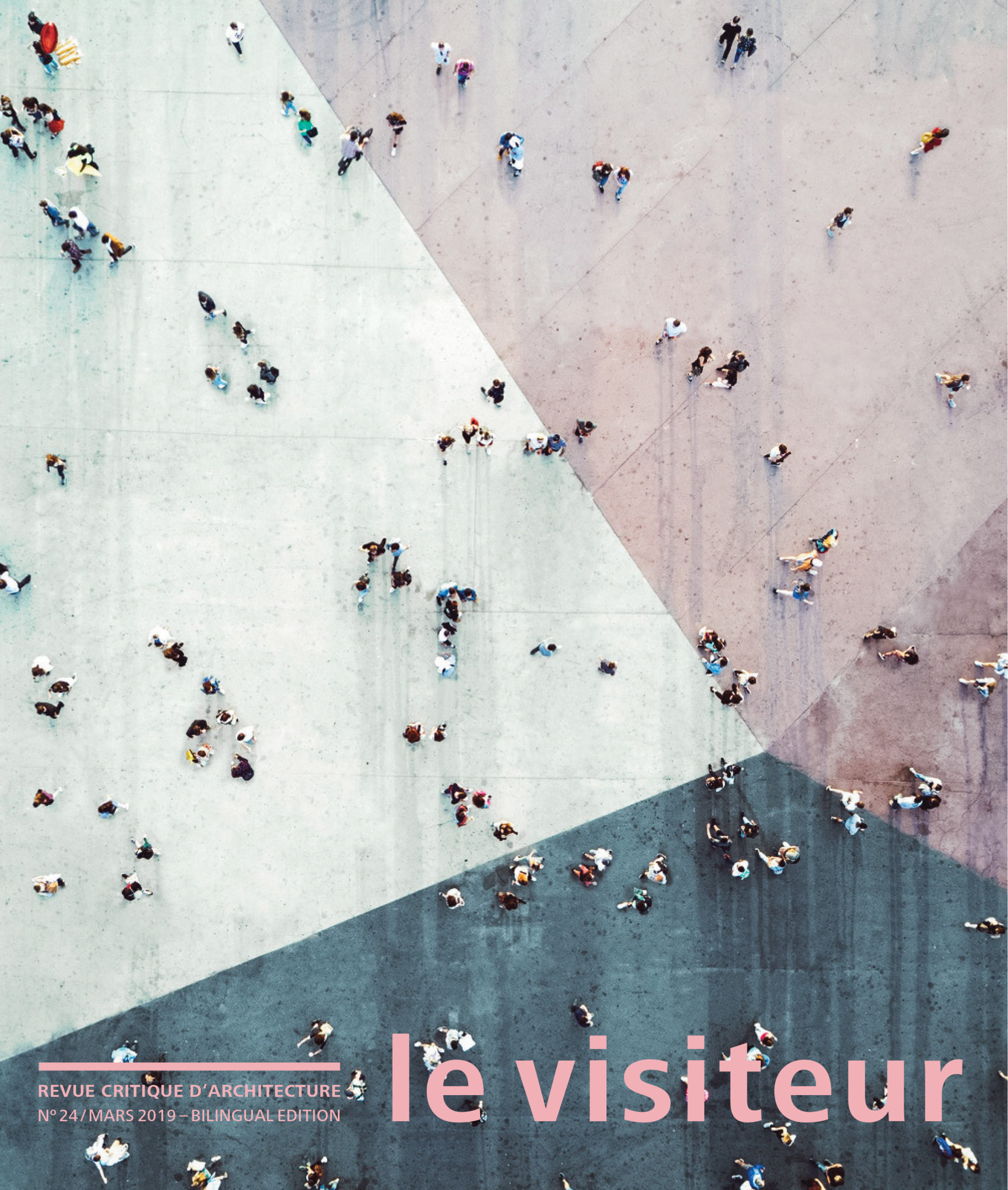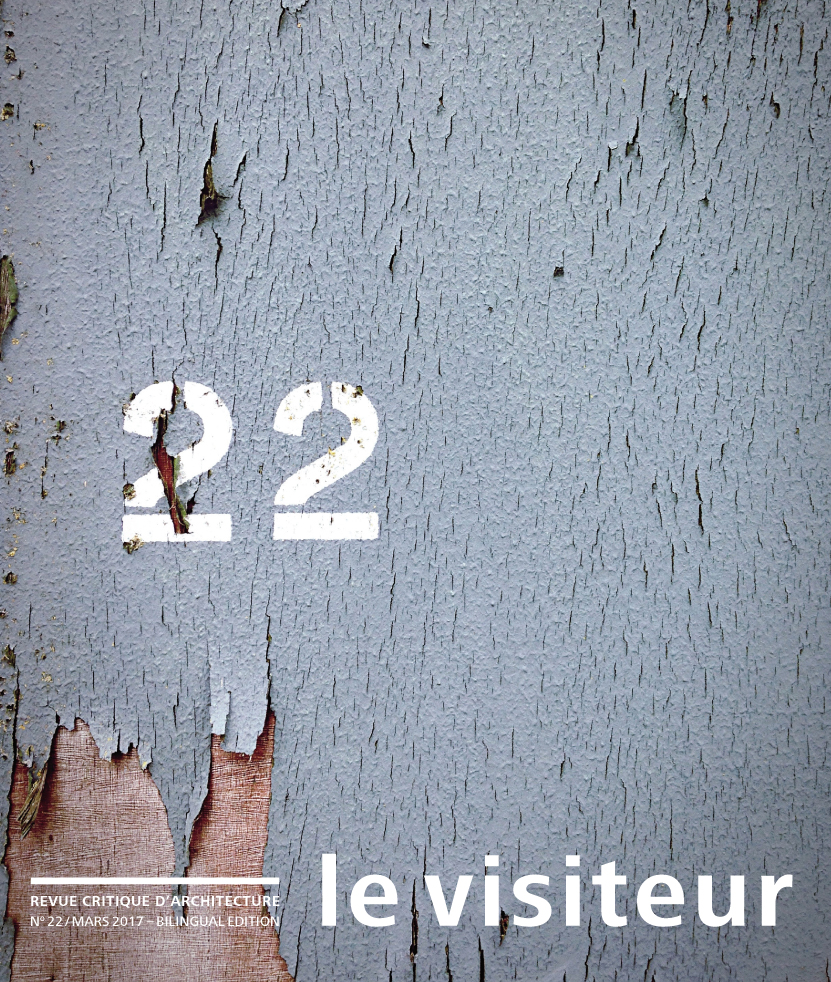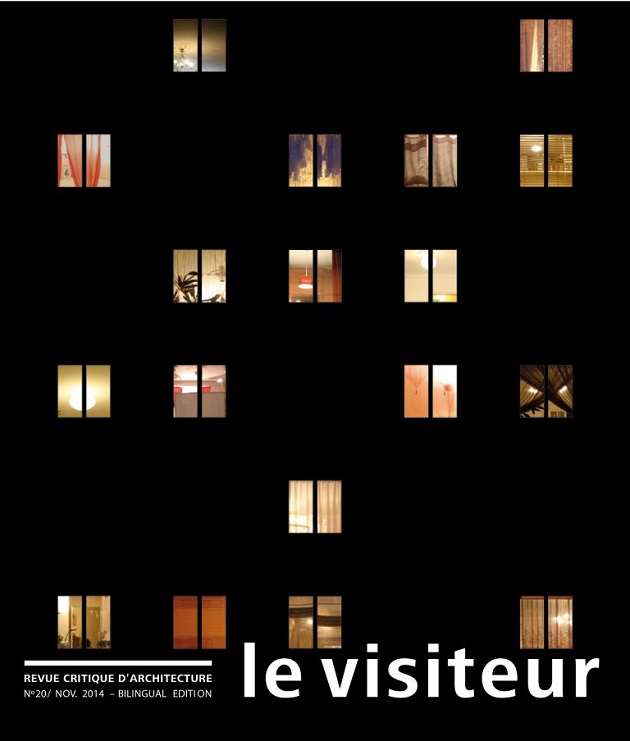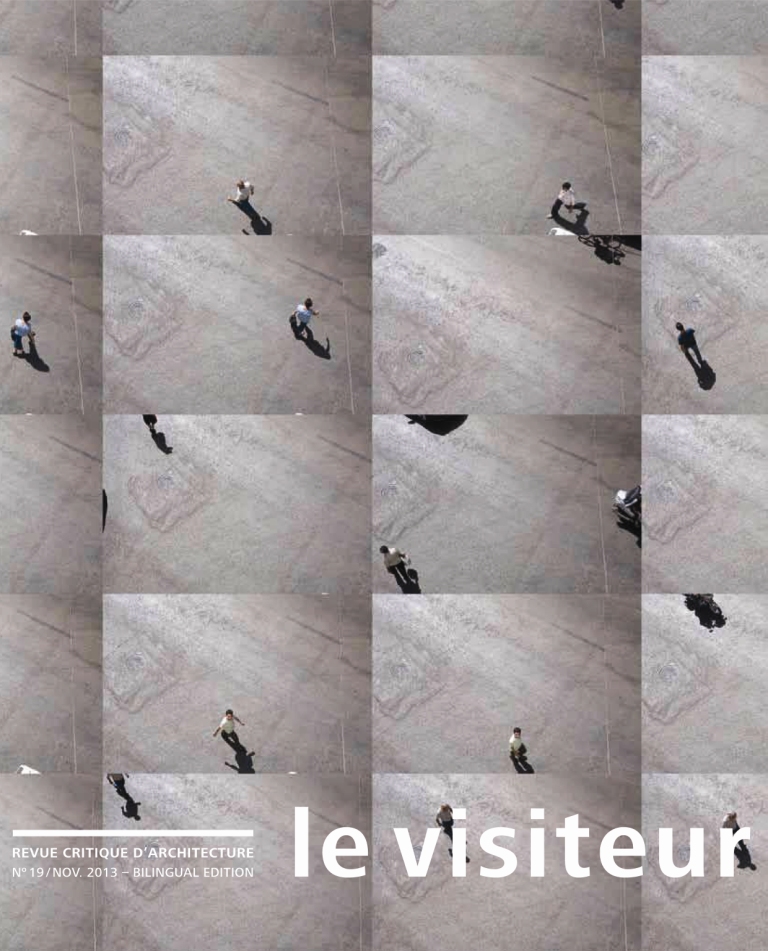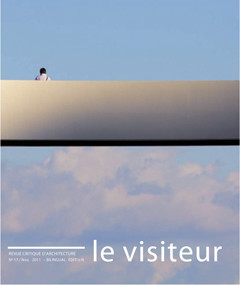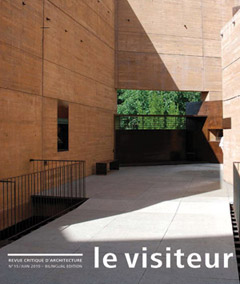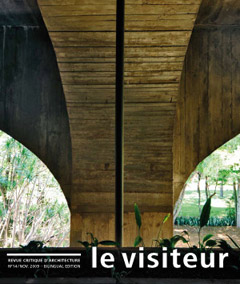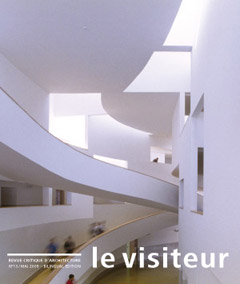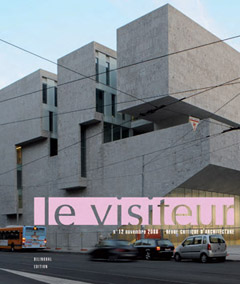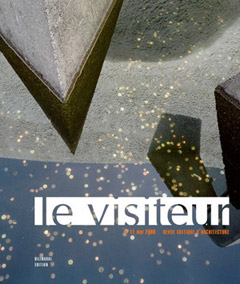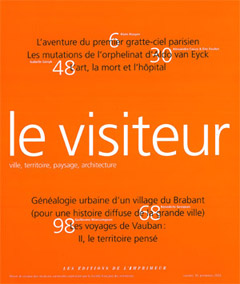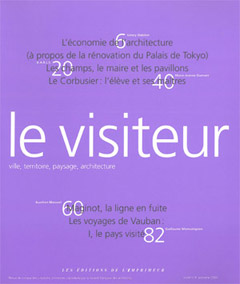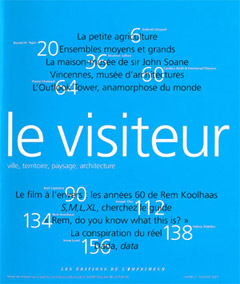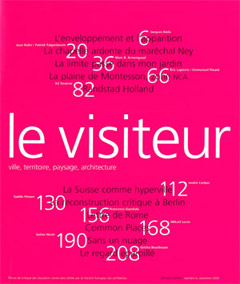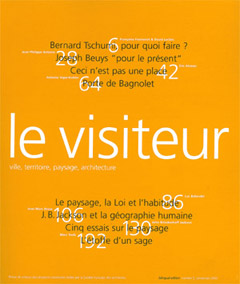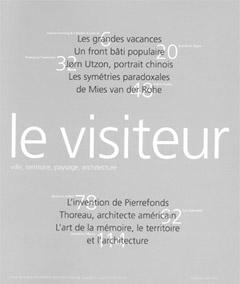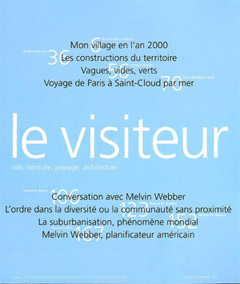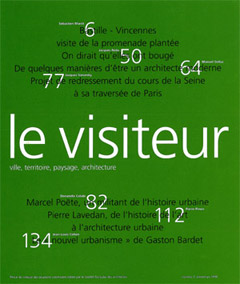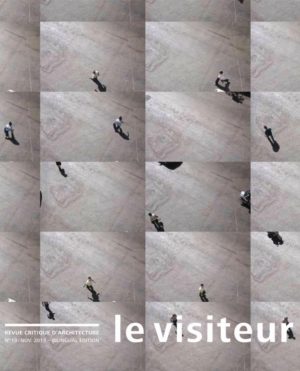Description
Publication date: 2013
Editorial: Silence of light, world conversation
Karim Basbous
Read moreThe buildings by Alberto Campo Baeza and Mauro Galantino that introduce this issue of Le Visiteur are constructed around simple, frank, appropriate figures whose modernity – neither exhibited as a self-referent high-tech showcase, nor discreetly masked – is, as in Granada and Orta San Giulio, part of a knowledgeable, wide-ranging conversation with the structures of the past. In them we rediscover the themes that underpin architecture and survive the ups and downs of the merely topical: hollow volumes for living in, space colored by the lighting of its textures, and the power and virile sensuality of welcoming walls. All of this speaks to us not only of use and pleasure, but also of an intellectual adventure, of the odyssey of the type down the ages.
Laurent Salomon addresses the guiding thread of Campo Baeza’s career, both as a student and in his projects and his ongoing concern with light and structure; and Marco Mulazzani, in his report on morphology, type, scale, and memory, looks into the “critical project” applied by Mauro Galantino.
Laurent Salomon speaks of Campo’s “discretion”. Galantino, for his part, belongs to a major tradition in Italian architecture, that of the project fueled by subtle political and social analysis: slipping into the gaps in the system to shape spaces rare in our times, he acts politically. It is this theme – the relationship between architecture and politics – that the articles to come explore.[1]
What can architecture do? Where is the architectural and urban project at as a means of reshaping the world? Where is architecture at as a subject of public interest, and what is its role in the process of social change? To what extent it is still involved in the planning of the real world? These are the questions our contributors set out to answer.
The street, wrote Victor Hugo, is the umbilical cord linking the individual to society. Jean-Christophe Bailly brings his distinctive style to a fresh look at this street, not just as part of our cities, but in its haunting of our cinema, our literature and our memory. In speaking of it he homes in on the solitude of architecture in today’s world. Paul Chemetov, known for his keen interest in public affairs, examines issues equally relevant to modern architecture and contemporary politics: questions of numbers, the city, and the actual idea of a social project lead him back to a concept of “common sense.” Almost eighty years after the Athens Charter Andrea Branzi returns to the tradition of universal doctrines, with no qualms about facing up to the masters: from a lucid assessment of change in today’s world, he adduces ten points the architectural urban project can work from. Olivier Gahinet probes the political scope of the project, elaborating a concept of democratic building that leads him to analyze the form of squares and major buildings by dissociating their initial purpose – linked to the immediate sociopolitical context – from the political implications that emerge much later. Philippe Sers, driven by his curiosity to an exploration of marginal matters, and the ambiguous, secret places between art and architecture, tackles the utopian function of the work of art via the Russian avant-garde. Politics comes with the territory, and Nadia Tazi picks up on the space-society connection in the distinctive context of Islam: referencing Ibn Khaldun, she contrasts the Bedouin with the city dweller, the desert with the city, and anarchy with despotism, in a scrutiny of the political turn of events that recently led to the Arab Spring.
Architecture has become a tool of power whose links with the economic and social workings of urban development must be understood. Two articles adopt this political/social perspective. The first bears on Greater Paris, which has made us aware that to think about a territory we must first to able to represent it. Nathalie Roseau’s analysis leads her to singular hypotheses regarding representation of the metropolis, that spatiotemporal reality which cannot be reduced to a mere aerial view. Virginie Picon-Lefebvre turns her attention to the evolution of the emblematic Les Halles neighborhood, from Napoleon III to Delanoë: a comparison of ventures spanning three eras that looks at the official motivations underlying redevelopment of the heart of France’s capital.
Both of these large-scale Parisian undertakings are attempts to restore Paris to membership of the world-city circle, in a context in which the growth of certain megalopolises pays no heed whatsoever to the concept of the project. In his survey of the functioning of big projects around the world, Joseph Rykwert points up a link between the profession’s theoretical shortfall and the weakening of the architect’s political role. This issue of Le Visiteur closes with opinions from an architect – a committed practitioner and theoretician – for whom architectural form can be explained politically: Herman Hertzberger’s interview with Alessandro Delli Ponti returns to the meaning of “welcoming form,” elaborates on the concept of spatial intimacy, stresses Structuralism’s contribution to architecture, and comments on recent change within the discipline. It is in the thinking of such an “all-round” architect that gains in knowledge, hands-on design experience, and political will can come together productively.
[1] Many of these texts emerged from the colloquium organized by the la Société française des architectes and the CNRS on 1-2 June 2012 in Paris, with the backing of the Urbaine de Travaux building group.
Translated from the French by John Tittensor
Architectural stopovers: Spain, Italy
Luminous Geometry
Laurent Salomon
Read moreWhenever light – inner or outer – is carved with the scalpel of “impeccable geometry,” we arrive at the diametrical opposite of random forms. Alberto Campo Baeza, an architectural soothsayer who calls upon humanity to rediscover itself in philosophy, advances the singular argument that architecture must remain subject to the primordial mastery of two elements, gravity and light. He views it as a learned art capable of transcribing ideas in space and henceforth in light. His radical ambitions are not materialized in any articulated textuality, nor do they employ technical prowess to recreate an ontologically Vitruvian classicism. In his quest for distillation, Campo Baeza makes ostensible use of an elementary geometry that links him to Mies van der Rohe, but he concretizes it through a light-capturing materiality that accords with Le Corbusier’s aspirations. He feels that the truth of a work lies in its capacity for critical expression – his cause is exclusively architectural, yet he embraces the unchanging nature of the human condition with its persistent metaphysical interrogations, values that he contrasts to the superficiality of the present, the ephemeral aspect of current events, and the vanity of ambition. Should we therefore see his pure, white work as the expression of an essentialness distilled from the materialism of the present, or might it represent a refined veil that masks the discharge of carnal tension which still flashes throughout Trajan’s Spain?
What architecture promises
Marco Mulazzani
Read moreThe contemporary scene is marked by an irreconcilable rift, separating the surfeit of ugly buildings that disfigure both cities and countryside from the few unique works of sophisticated (though often computer-generated) beauty. The idea is becoming ever more rare that architecture can improve the quality of the environment, since all it does is to transform the environment through applying whatever “special effects” are in fashion. The project and the control of space are the “perennial” techniques designed to create spaces that can accommodate and express the dual condition of human life, that is to say the need to live day by day and simultaneously to escape the constraints of the everyday. During a career as both professional architect and researcher, lasting over thirty years, Mauro Galantino has sought to get beyond the contingency of the projects he took on, in order to bring the practical and the ideal face to face in real constructions. This paper offers some thoughts on the ideas “for the dwelling” that have guided Galantino’s work through the projects he has implemented on various scales, from interior renovation projects to urban projects, and seeks to explain the unity of thought underlying them. “Architecture is a strange discipline, one that controls space in order to give those who enjoy it the means to imagine, beyond it, that which still forms part of space but is no longer measurable. And in this extended space, in this ‘sea,’ time resonates. It is both time ‘present,’ as represented by the building, and time ‘other,’ which time present encircles without revealing, but which the human imagination incessantly pursues.”
Architecture and politics
Towards the reintegration of architecture
Jean-Christophe Bailly
Read moreAll the products of culture, in all periods, possess a political valence. But for architecture, which embodies social forms, the connection is an organic one, and from very early on it made for a split between a monumental aspect, linked to power, and a kind of prosaic openness to all comers. The attempt to lessen this dichotomy by creating modes of production disconnected from private property has been a constant source of tension in the history of architecture: utopia is not a supplementary feature but a key function of architecture. But while the modern movement, though abandoning the street, that condition of individuation, sustained the utopia-seeking tension, we are now witnessing a polarization of the Big Thing and the abandonment of this tension. Consequently there has emerged on the immediate horizon the need to find and establish an architecture that is reintegrated, capable of reinventing social form while leaving behind the fascination with objects of power.
Architecture for the masses and modern politics
Paul Chemetov
Read moreThe topic “Architecture and politics” should not be confused with “Architects and political authorities.” Simply referring to architecture as imperial or Fascist will not save us from the pitfalls of a purely stylistic interpretation. Piacentini and Terragni both worked under the government of Benito Mussolini on projects championed by his regime. Their views were – one hopes for their sake – Fascist, but their projects were not: the Via della Conciliazione did not take the Casa del Fascio in Como as its model. Architecture and modern politics have the same concern: large numbers. Their mutual attraction arises from this same source. Universal suffrage goes hand in hand with housing for all, education for all, and health care for all – both physical and mental, through sport and culture. This is a new project. In Apollo and Democracy, Walter Gropius analyzed the connections between the Weimar Republic and the Bauhaus. This established the public nature of architecture. Architecture’s project is to transform and express the material, constructed world, and hence also the practices and representations of human society. Modern politics has the same project; some modern architects have even believed that subversion in the sphere of politics paralleled the forms they explored. This connection cannot be implemented, in my view at least, except through a new alliance of politics, ethics, and culture of the kind that Gorbachev called for, a bitter acknowledgment of the flaws of the system that he sought to reform. The pursuit of this common project is what the title “Architecture and Politics” calls for. Voluntarism alone is not such a project, any more than an image is a project rather than merely one object among others. Perec spoke of things. The architecture of consumer society, marked by the speeded-up obsolescence of objects and emotions, is not political in the critical sense assigned to the term by Ernst Bloch when he called for utopia to compensate for the absence of the future. The possibility of a relationship between architecture and politics presupposes citizens, not subjects – political animals, democratic animals, who do not live by the bread of games alone. Architectural games only amuse the bureaucracy, as Gian Carlo de Carlo pointed out over thirty years ago at the Venice Biennale. Today we are no further forward.
The project in the age of the crisis of globalization: toward a new Athens Charter
Andrea Branzi
Read more1 – The city as a high-tech favela
2 – The city as a computer for every 20 square meters
3 – The city as a site of cosmic hospitality
4 – The city as a single air-conditioned space
5 – The city as a genetics laboratory
6 – The city as a cluster of living plankton
7 – Search for models of weak urbanization
8 – Creation of indeterminate and easily penetrated boundaries
9 – Creation of lightweight and reversible infrastructures
10 – Creation of major transformations via micro-projects
These projects are not intended to be carried out. What is at issue here is not a utopia for the city of tomorrow, but a reflection on the city of the present. The world has changed, but the culture of the project has not changed with it. The city is no longer an ensemble of architectural boxes but an area filled with people, equipment, information, and virtual relationships. Models of weak urbanization seek the coexistence of architecture and agriculture, technology and meteorology, dairy cows and sacred cows. We live in a world that has no outside, either political or geographical, a global world that is the sum of many local environmental and economic crises. This world is infinite, but indefinite; unlimited, but with limits to development; monological but ungovernable; without borders, but with no overall conception of itself. It is a world made up of many worlds, an exasperating, polluted world in which everything is at once growing and vanishing; to keep going it has to re-form itself every day with new laws, new regulations, new projects, so as to manage its own uncontrolled activity. Each intervention must be reversible, incomplete, flexible, because whatever is determinate is dangerous. It is an infinite world whose space is occupied by the bodies of seven billion people, by the flow of information, and by countless consumer goods that generate circles, aggregations, and vibrations that completely fill up the urban scene. The only possible way to reform the city must be sought in the interstitial spaces, in household economies, in human relations, and in our own heads.
The Art of Giving
A brief outline of democratic architecture
Olivier Gahinet
Read moreThere is a connection between modern architecture and democracy, a connection that will be discussed here the better to understand, embrace, and introduce it into contemporary architecture.
Exploring the relationship between modern architecture and democracy means pursuing an idea raised a century ago by Frank Lloyd Wright. It also means wondering how architecture can be political today or, more precisely, how architects can contribute, with their specific skills, to a transformation of society. The most radical approach today would probably require building on – so to speak – the advice notably given by Guy Debord, followed by Manfredo Tafuri: Don’t Build.
But that may not be the only answer.
In contrast to today’s “all-enclosing” architecture, we must continue to propose buildings that make it possible to live with and contribute to the city. And we must also ask how today’s architecture might speak to a better world, one that adopts fraternity as an ideal. This article will proceed by examining several examples in the history of architecture of spaces and buildings that symbolize freedom and life in society, and will suggest several paths toward to a truly democratic architecture. The latter does not refer to “architecture in a democracy” (some totalitarian societies have produced democratic buildings) nor to some kind of participatory architecture. Instead, the definition of what is called a democratic building involves an edifice that transcends its purpose in order to embody the participation of all citizens in the life of their city.
Social utopias and prophetic utopias
Philippe Sers
Read moreIn Russia after 1917, the intelligentsia and the art world welcomed the upheavals generated by the October Revolution, not only because they saw in them the possibility of establishing social and architectural utopias, but also because artists, philosophers, and even theologians saw the beginnings of a revolution on the spiritual plane. We examine the interplay of social utopias and prophetic utopias (in the biblical sense of the term) and the deeper meaning of the concept of utopia, by analyzing some examples of contemporary culture – from Tatlin’s Monument to the Third International to Filliou’s Poïpoïdrome in more recent years – and contextualizing them within the great spiritual tradition.
Space and the political realm in the Islamic world: between the desert and the city
Nadia Tazi
Read moreI propose to do a little “conjectural history,” first by describing archaeologically the impact of the desert, understood as a unique region, on politics in the Islamic world – or how this type of space, sharply distinct and extreme, inevitably generates an aristocratic form of social relations and behavior, resistant to the consensus advocated by Islamic dogma. I draw particularly on the “geopolitics” of Ibn Khaldun, who contrasted the Bedouin, “nervous, proud, tough,” “more capable of domination and resistant to all authority,” with the city-dwellers, cultured and peaceful, but all too ready to give in to spinelessness and luxury, to the point of becoming “like women and children who depend on the head of the family,” in other words, signing on to a despotic regime. History unfolds cyclically, alternating these two political cultures, which are both diametrically opposed and interdependent. They can both be studied from a spatial perspective rather than a temporal or historical one (the one fetishized by so many Islamists today).
Metropolitan Projects as Narrative
Nathalie Roseau
Read moreA consultative call for urban plans for Greater Paris, dubbed the Consultation Internationale du Grand Paris, triggered stimulating debate over the crucial issues facing major metropolises. Various approaches attempted to come to terms with the globality of the “metapolis” and potential ways of dealing with it. Architects played a privileged part in this broad analytical process, notably questioning the role of their profession in building metropolises faced with ever-denser flows, constant obsolescence, and the difficult task of making architectural intervention intelligible. In the most “operational” phase of implementation, designs for Greater Paris forthrightly explored the issue of conceiving metropolitan projects as a new, collective way of conceptualizing and acting upon a city. This article discusses the imposing corpus of work generated by the consultative process, using that event to question the fabric of metropolitan projects in large contemporary cities. One of the emerging paradigms addressed here is urban polycentrality, understood in a polysemic way. The change in the meaning of “project” triggered by the metropolitan dialectic then leads to an examination of two experiments that came in the wake of the Consultation Internationale du Grand Paris, namely the Grand Paris Express project and the development of the Saclay area.
The Heart of Paris: designing Les Halles – architecture, taste and politics (1854-2012)
Virginie Picon-Lefevre
Read moreWhat family tree does the current project for Les Halles belong to? What are we to make of the choice to create here an empty green space, a relatively small public park, when the consultative call organized by the City of Paris in 2003 had produced other development alternatives for the heart of Paris? And why choose to roof the renovated shopping mall with a “Canopy”?
Working from the drawings and images produced by the architects and town planners to convince both the authorities and local residents, I should like to examine the evolution of the urban doctrines supported by politicians from the original Baltard project through the Seura-Mangin one. I shall compare this latter to projects that let us track the evolution of the political view of the center of Paris: from the Baltard Halles to the 1967 consultation for a deliberately disproportionate modernist center, to the formalist project which, though now demolished, embodied recognition of the virtues of the old city, as realized by Vasconi and Pencreac’h, with Louis Arretche for the gardens and Willerval for the Umbrellas. The intention here is not to write a complete history of the projects for Les Halles, but rather to identify changes, differences, and the references drawn on by the architects in three respects: composition of the overall plan, architectural form, and public space.
Building and Politics
Joseph Rykwert
Read moreThe kinship as well as the disparity between sociology and architecture are notable. Both are inescapably historical in that their work is tracing and explicating past events; yet when sociologists move from theoretical discourse to project, reflection turns into action; this has been true since Saint Simon and Auguste Comte. In architecture cognition modulating into action is building – or at least a plan.
The weakness of recent architectural speculation has been witnessed by the quick changes of stylistic fashion over the last decades, which went without any real theoretical backing to the projects. From brutalism to ‘post modern’ to high-tech (by far the most pervasive) to ‘de-constructivism’ and in turn to ‘parametrics,’ these changes have been taking place while some vast built projects – in China and in the Emirates, for instance, which belong to the lower reaches of high-tech – have been forced into narrative twists (palm-shaped artificial islands, sail-shaped high-rises) so as to introduce variety on the inevitable monotony imposed on urban structure by the nudities of steel and glass.
Where, if blame there is, does it lie? Largely in the social/economic pressure which in the course of the late nineteenth century organized what had been the architect’s craft or even an art into an organized profession, and is now consolidating that profession into business ventures which need no theoretical reflection to pass into action.
If that is seen as a problem which demands a solution, it may lie outside the bounds of the profession and require some political – and therefore historical understanding – of the architect’s role which the current financial crisis may do something to promote.
Knowledge Landscapes
An Interview with Alessandro delli Ponti
Herman Hertzberger
Read moreHerman Hertzberger, RIBA Golden Medal 2012, has been, since the early sixties, a major protagonist of those heteronomous movements which, by deeply studying the impact of social sciences and structuralism on the architectural discipline, have developed a path towards spatial imagination and design processes alternative to the self-referential certitudes of the Modern Mouvement,.
His personal journey is both prosperous in built masterpieces, from the Montessori School in Delft (1966-1970), to the recent extension of the NHL University in Leeuwarden, as well as in editorial works: Lessons in Architecture, Articulations (Prestel), Space and Learning, The schools of Herman Hertzberger (010 Editions), just to mention a few.
Throughout his entire career, Herman Hertzberger has been passionately engaged in overcoming the limits of the rationalistic program’s disciplinary autonomy in favour of a relational approach to space.
His built educational buildings – authentic schools to apprehend Space – are the perfect manifestos of this research.
This interview was conducted with the intention of deepening our comprehension of the correlation between the project and the spatial relational rendition of knowledge, it has also been a pleasant occasion to continue the debate initiated during his conference at the Société Française des Architectes, in June 2011, and to try to clarify the meaning of expressions such as “Interpretativeness” and “Spatial Temptation”.

